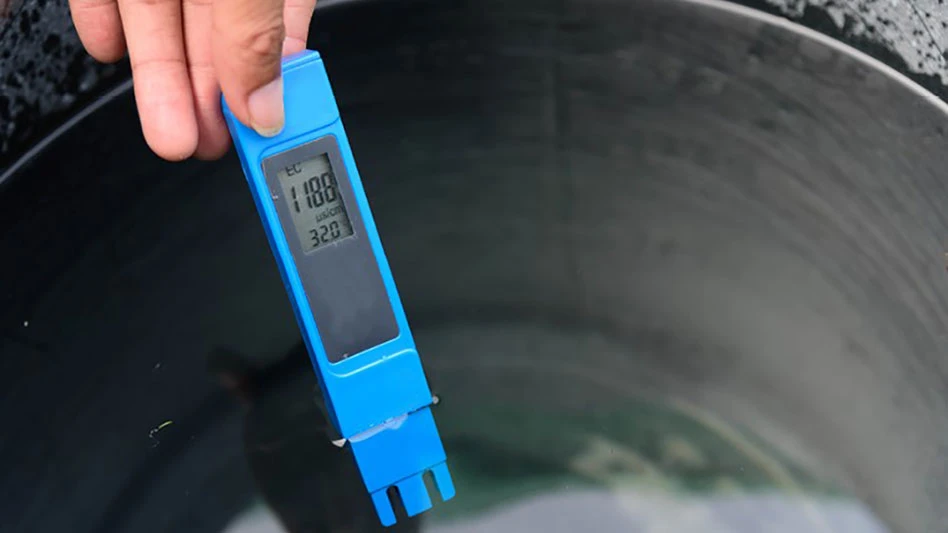

Nutrient problems can show up in your crop quickly. Perform regular soil tests so that you can identify problems early and take corrective action. Train your staff to recognize nutritional disorders so that they can scout while working in the crop.
Checking your plants weekly is the key to managing greenhouse nutrient problems. Check the color and vigor of the foliage, as well as the health of the roots. Even though the foliage is showing nutrient deficiency symptoms, the root problem may be pest, disease or water-management related, rather than fertilizer type or concentration. Checking the roots is important because the plant may have a compromised root system due to Pythium, fungus gnat infestation or waterlogged and poorly drained media.

Conducting regular testing of media pH and EC is vital. pH affects the availability of nutrients and EC gives you the overall concentration of fertilizer salts in the media. For plugs, test two to three times per week, because their smaller media volumes are more susceptible to changes compared to bigger volumes. For flats and 4-inch pots, test once a week, and for containers 6 inches or larger, every two weeks.
These two testing methods are easy to do in the greenhouse:
Pour-through: Irrigate the crop one hour before testing. Select five pots and place plastic saucers under them. Pour distilled water on the surface of the media. The amount of distilled water depends on the size of the pot: For cell packs and 4-inch pots, pour 50 ml (1.7 oz), for 6-inch pots, 75ml (2.5 oz), and for 6 ½ -to 8-inch pots, pour 100 ml (3.3oz). Collect the leachate and test pH and EC as soon as possible. For plugs, place containers under the plugs, then press on top of the plugs’ media to collect leachate.
1:2 Method: Randomly select five pots and collect a small amount of root media from the lower 2/3 of the pot. Mix thoroughly and remove any slow-release fertilizer capsules to avoid inaccurate EC values. Add distilled water twice the volume of soil. Mix thoroughly and allow to sit for 30 minutes before testing EC and pH of the slurry.
Select one method and stick to it. Establish a target range depending on your crop. For iron-inefficient crops, also known as the petunia group (petunia, calibrachoa, pansy, nemesia, bacopa, dianthus, snapdragon, verbena and vinca), the acceptable pH range is 5.4-6.2.
For iron-efficient crops, or the geranium group, (seed and zonal geranium, marigolds, New Guinea impatiens and lisianthus), the acceptable pH range is 6.0-6.6.
For other crops such as impatiens, ivy geraniums, poinsettia and chrysanthemums, the acceptable pH range is 6.0-6.4. A range of 6.0-6.2 would be acceptable for most crops.

Troubleshooting nutritional problems in the greenhouse
Symptoms may be caused by other problems such as root rot disease, insects or poor drainage in the root media. To confirm that the symptoms are nutritional you have to rule out all other causes. You also need a soil test to confirm the nutrient element causing deficiency or toxicity symptoms.
Source: University of New Hampshire Extension, extension.unh.edu

Explore the March 2023 Issue
Check out more from this issue and find your next story to read.
Latest from Greenhouse Management
- 2025 Proven Winners Horticulture Scholarship applications now open
- How to improve inventory and shipping management in the greenhouse
- Leading Women of Horticulture: Anna Ball, Ball Hort, and Terri McEnaney, Bailey Nurseries
- GM CEA HERB Part 2: A guide to increasing the sowing density of culinary herbs
- GM CEA HERB Part 1: Best practices for producing culinary herbs in controlled environments
- USDA fires experts on invasive pests, including Asian citrus psyllid, chilli thrips
- CEA Alliance celebrates bipartisan introduction of Supporting Innovation in Agriculture Act
- Dümmen Orange North America celebrating 25th anniversary in 2025






